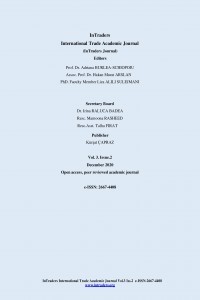Uçak Etkinliğinin Operasyonel ve Finansal Metrikler Açısından Analitik Olarak İncelenmesi
Bu çalışmada dar gövdeli Boeing B737-700 ve Airbus A319 uçakları ile geniş gövdeli Boeing B777-200 ve Airbus A330-300 uçaklarının örnek veriler üzerinden karşılaştırmalı etkinlik analizlerinin finansal ve operasyonel göstergeler kullanılarak yapılması amaçlanmaktadır. Bu çalışmada TOPSİS yöntemi kullanılarak yapılan analitik çalışmada kullanılan veriler esas alındığında; bölgesel uçuşların gerçekleştirildiği dar gövdeli uçaklardan B737-700’ün, A319’a göre; uzun mesafeli ve kıtalar arası uçuşların gerçekleştirildiği geniş gövdeli uçaklardan A330-300 uçağının, B777-200 uçağına göre maliyet avantajına sahip olduğu belirlenmiştir. Çalışmada ayrıca kullanılan radar grafik yöntemine göre; A319 dar gövdeli uçağın B737-700 dar gövdeli uçağa göre genel olarak daha üstün operasyonel özellikler gösterdiği; B777-200 geniş gövdeli uçağın ise A330-300 geniş gövdeli uçağa göre genel olarak daha üstün operasyonel özellikler gösterdikleri belirlenmiştir.
Anahtar Kelimeler:
Dar Gövde Uçaklar, Geniş Gövde Uçaklar, Opersyonel Özellikler, Finansal Özellikler, Topsis Yöntemi
Analytical Investigation Of Aircraft Efficiency In Terms Of Operational And Financial Indicators
In this study, it is aimed to make comparative efficiency analysis of narrow-body aircrafts Boeing B737-700 and Airbus A319 as well as of wide-body aircrafts Boeing B777-200 and Airbus A330-300 using financial and operational indicators. Based on the data used in the analytical study, using the TOPSIS method, the results show that in regional flights where the narrow-body aircrafts operate, the B737-700 aircraft compared to A319; and where the wide-body aircrafts are utilized in long-haul and intercontinental flights, the A330-300 aircraft compared to the B777-200 aircraft was determined to have a cost advantage. According to the radar graphic method used in the study; the A319 narrow-body aircraft generally showed superior operational characteristics compared to the B737-700 narrow-body aircraft; and the B777-200 wide-body aircraft was determined to have superior operational characteristics compared to the A330-300 wide-body aircraft.
Keywords:
Narrow Body Aircraft, Wide Body Aircraft, Operational Characteristics, Financial Charesteristics, Topsis Method,
___
- Andresen, G. ve Williams, Z. (2006). “Metrics, Key Performance Indicators, and Modelling of Long Range Aircraft Availability and Readiness”. Erişim adresi: https://www.sto.nato.int/publications/STO%20Meeting%20Proceedings/RTO-MP-AVT-144/MP-AVT-144-07.pdf
- Baharozu, E., Soykan, G. ve Ozerdem, M. B. (2017). “Future aircraft concept in terms of energy efficiency and environmental factors”, Energy, 140:1368-1377. Doi: 10.1016/j.energy.2017.09.007
- Bakir, M., Akan, Ş., Kiraci, K., Karabasevic, D., Stanujkic, D. ve Popovic, G. (2020). “Multiple-criteria approach of the operational performance evaluation in the airline industry: Evidence from the emerging markets”, Romanian Journal of Economic Forecasting, 23(2): 149-172. Erişim adresi: https://hdl.handle.net/20.500.12508/1537
- Gerede, E. (2015). “Havayolu taşımacılığı ve ekonomik düzenlemeler teori ve Türkiye uygulaması”, Ankara, Sivil Havacılık Genel Müdürlüğü Yayınları.
- Gökdalay, M. H. ve Evren, G. (2011). “Havaalanlarının performans analizinde bulanık çok ölçütlü karar verme yaklaşımı”, İTÜ dergisi, 8(6): 157-168. Erişim adresi: http://hdl.handle.net/11527/4850
- Hansen, M. ve Zou, B. (2013). “Airport Operational Performance and Its Impact on Airline Cost, Modelling and Managing Airport Performance: 119-143. Doi: 10.1002/9781118535844.ch5
- Kalemba, N. ve Planas, F. (2019). “Safety And The Economic and Financial Performance in the Airline Industry: Is There Any Relationship”, Aviation, 23(1): 7-14. Doi: 10.3846/aviation.2019.9744
- Kiracı, K. ve Yaşar, M. (2020). “The Determinants of Airline Operational Performance: An Empirical Study on Major World Airlines, Sosyoekonomi, 28(43): 107-117. Doi: 10.17233/sosyoekonomi.2020.01.06
- Lee, J. J., Lukachko, S. P., Waitz, I. A. ve Schafer, A. (2001). “Historical and future trends in aircraft performance, cost, and emissions, Annual Review of Energy and the Environment, 26(1): 167-200. Doi: 10.1146/annurev.energy.26.1.167
- Lee, J. J. (2010). “Can we accelerate the improvement of energy efficiency in aircraft systems?”, Energy conversion and management, 51(1): 189-196. Doi: 10.1016/j.enconman.2009.09.011
- Lee, J. J. (2019). “Effects of operational performance on financial performance”, Management-Science-Letters: 25-32. Doi: 10.5267/j.msl.2018.11.003.
- Mahtani, U. ve Garg, P. C. (2020). “An analysis of factors affecting financial distress of airline companies: the case of India”, Int. J. Business Excellence, (20)1: 130-148. Doi: 10.1504/IJBEX.2019.10024548.
- McLean, D. (2006). “The Operational Efficiency of Passenger Aircraft”, Aircraft Engineering and Aerospace Technology: An International Journal, 78(1): 32-38. Doi: 10.1108/17488840610639663
- Nangia, R. K. (2006). ”Efficiency parameters for modern commercial aircraft”, The Aeronautical Journal, 110 (1110): 495-510. Doi: 10.1017/S0001924000001391
- Özer, A. (2008). “Küreselleşme Kıskacında Yönetim”, Erişim adresi: http://mail.ceis.org.tr/dergiDocs/makale232.pdf
- Sarsour, N. ve Adalaou, E. (2021). “An operational performance assessment of Turkish airline companies based on return on invested capital tree model”, Gazi İktisat ve İşletme Dergisi, 7(2): 95-103. Doi: 10.30855/gjeb.2021.7.2.001.
- Türk Hava Yolları. (2020). 2020 Sonuç Özeti. Erişim adresi: https://investor.turkishairlines.com/documents/presentations/ir-presentation-4q20tr7.pdf.
- Vasigh, B., Taleghani, R. ve Jenkins, D. (2012). Aircraft Finance: Strategies for Managing Capital Costs in Turbulent Industry, J.Ross Publishing.
- Verstraete, D. (2015). “On the energy efficiency of hydrogen-fuelled transport aircraft”, International Journal of Hydrogen Energy, 40(23): 7388-7394. doi: 10.1016/j.ijhydene.2015.04.055
- Yayın Aralığı: Yılda 2 Sayı
- Başlangıç: 2018
- Yayıncı: Kürşat ÇAPRAZ
Sayıdaki Diğer Makaleler
Uluslararası Vergileme İş Birliğinde Güncel Eğilimler
Andrijana BOJADJİEVSKA DANEVSKA
Uçak Etkinliğinin Operasyonel ve Finansal Metrikler Açısından Analitik Olarak İncelenmesi
María Jesús ARROYO FERNÁNDEZ, Pedro FERNÁNDEZ SÁNCHEZ, María-carmen GARCÍA-CENTENO, Inmaculada HURTADO OCAÑA
The Competitiveness Position of The Republic of North Macedonia: Opportunities And Weaknesses
Kristina VELİCHKOVSKA, Nehat RAMADANİ
The Innovation Development of the European Union: Regional Clustering
